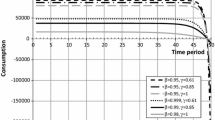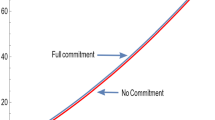Abstract
Under a particular class of utility functions, intertemporal price discrimination (IPD) is not feasible. That is, customers cannot be made to pay different prices for a durable good at different points in time. Other factors such as falling costs, and differing discount rates between buyers and sellers have been found to make intertemporal pricing schemes feasible, or even profitable. None of these factors, however, were fundamental demand differences which give rise to static price discriminations. In this paper we argue that IPD is indeed feasible and sometimes profitable, if only we allow for a nondurable good in the utility function. A simple additively separable utility is examined first, which is then extended to a nonseparable utility function which allows richer substitution/complementary relations between the durable and the nondurable goods. This may help us to better understand the similarities between static and intertemporal price discriminations.
Similar content being viewed by others
References
Bonüs, H. (1973): “Quasi-Engel Curves, Diffusion, and the Ownership of Major Consumer Durables”.Journal of Political Economy 81: 655–677.
Coase, R. (1972): “Durable Monopoly”.Journal of Law and Economics 15: 143–149.
Conlisk, J., Gerstner, E., and Sobel, J. (1984): “Cyclic Pricing by a Durable Good Monopolist”.Quarterly Journal of Economics 98: 489–505.
Cramer, J. S. (1957): “A Dynamic Approach to the Theory of Consumer Demand”.Review of Economic Studies, 24: 73–86.
Deaton, A., and Muellbauer, J. (1980):Economics and Consumer Behavior. Cambridge: Cambridge University Press.
Koh, W. T. H., and Leung, H. M. (1992): “Intertemporal Price Discrimination Revisited.” Working Paper Series no. 92-08, Faculty of Business Administration, National University of Singapore.
Landsberger, M., and Meilijson, I. (1985): “Intertemporal Price Discrimination”.Rand Journal of Economics 16: 424–430.
Pyatt, G. (1964):Priority Patterns and the Demand for Household Durable Goods. Cambridge: Cambridge University Press.
Stokey, N. (1979): “Intertemporal Price Discrimination”.Quarterly Journal of Economics 93: 355–371.
Van Cayseele, P. (1991): “Consumer Rationing and the Possibility of Intertemporal Price Discrimination”.European Economic Review 35: 1473–1484.
Varian, H. (1989): “Price Discrimination”. InHandbook of Industrial Organization, vol. 1, edited by R. Schmalensee and R. Willig. New York: North-Holland.
Author information
Authors and Affiliations
Rights and permissions
About this article
Cite this article
Leung, HM. Intertemporal price discrimination and consumer demand. Zeitschr. f. Nationalökonomie 65, 19–40 (1997). https://doi.org/10.1007/BF01239057
Received:
Revised:
Issue Date:
DOI: https://doi.org/10.1007/BF01239057




